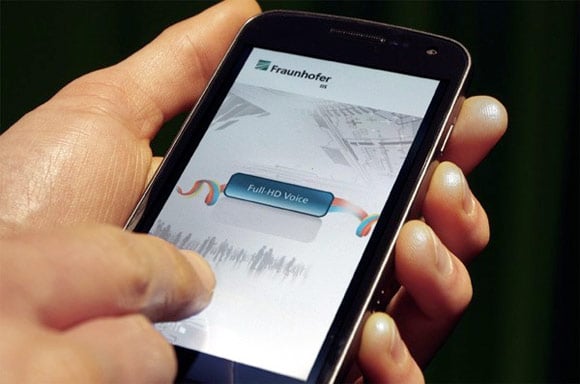Fraunhofer IIS Demos Full-HD Voice Over LTE On Android Handsets
Fraunhofer IIS may not be a super familiar name in the consumer realm, but in the world of research, there's hardly a company that comes up with crazier things than these guys and girls. The company has chosen Mobile World Congress as the place to present the world's first Full-HD Voice mobile phone calls over an LTE network. Verizon Wireless has toyed with VoLTE (voice over LTE) before, but we've seen nothing beyond semi-promising demonstrations. This particular method enables mobile phone calls to sound as clear as talking to another person in the same room, at a quality level that is equal to that experienced by consumers on any other audio/video device.
At the floor, there will be a live demo using Android phones, as the Full-HD Voice codec AAC-ELD has been integrated. There's an LTE network being set up at the show specifically for this demo. Unlike in mobile communications, Full-HD Voice is already established in several VoIP, video telephony and conferencing systems. "Every day, millions of users already make Full-HD Voice calls over IP connections," said Harald Popp, head of the department Multimedia Realtime Systems at Fraunhofer IIS, "With the introduction of LTE, now is the perfect time to introduce Full-HD Voice to mobile communications as well. Our AAC-ELD audio codec is the perfect solution for all upcoming mobile Full-HD Voice services."

Currently, the majority of phone calls are limited to 3.5 kHz. Emerging HD Voice services offered by some operators extend the upper limit to 7 kHz, whereas humans are able to perceive audio signals up to 20 kHz. The Full-HD Voice codec AAC-ELD gives access to the full audible audio spectrum available, offering more than four times the audio bandwidth of regular phone calls and at least twice the bandwidth of HD Voice services. In contrast to regular speech codecs, AAC-ELD also transmits also music and other audio signals at a quality level comparable with HDTV and BluRay – without increasing the bit-rates in comparison to today's phone services.
There's no mention of if this tech can be easily ported to iOS or Windows Phone, but given the market share that Android has, that's at least a solid start. Here's hoping companies actually jump on it; the tried-and-true phone number and "voice minutes" are long overdue for a more sophisticated replacement.
At the floor, there will be a live demo using Android phones, as the Full-HD Voice codec AAC-ELD has been integrated. There's an LTE network being set up at the show specifically for this demo. Unlike in mobile communications, Full-HD Voice is already established in several VoIP, video telephony and conferencing systems. "Every day, millions of users already make Full-HD Voice calls over IP connections," said Harald Popp, head of the department Multimedia Realtime Systems at Fraunhofer IIS, "With the introduction of LTE, now is the perfect time to introduce Full-HD Voice to mobile communications as well. Our AAC-ELD audio codec is the perfect solution for all upcoming mobile Full-HD Voice services."

Currently, the majority of phone calls are limited to 3.5 kHz. Emerging HD Voice services offered by some operators extend the upper limit to 7 kHz, whereas humans are able to perceive audio signals up to 20 kHz. The Full-HD Voice codec AAC-ELD gives access to the full audible audio spectrum available, offering more than four times the audio bandwidth of regular phone calls and at least twice the bandwidth of HD Voice services. In contrast to regular speech codecs, AAC-ELD also transmits also music and other audio signals at a quality level comparable with HDTV and BluRay – without increasing the bit-rates in comparison to today's phone services.
There's no mention of if this tech can be easily ported to iOS or Windows Phone, but given the market share that Android has, that's at least a solid start. Here's hoping companies actually jump on it; the tried-and-true phone number and "voice minutes" are long overdue for a more sophisticated replacement.

